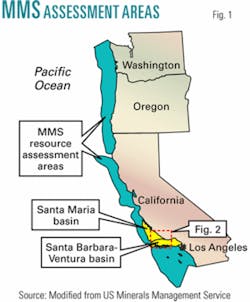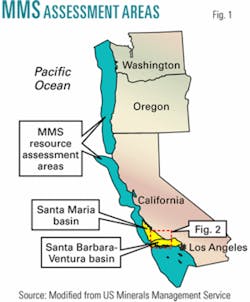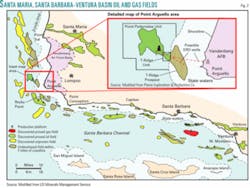Many facts about offshore oil and gas development relate to the formulation of a knowledge-based, rational national energy policy and should be a part of the current debate on offshore drilling legislation.
Recent progress in drilling technology, for example, can open new avenues of inquiry about the potential of an area where activity is severely limited by federal policy: the Pacific Outer Continental Shelf. The oil and gas supply possible from federal waters off the US West Coast might in fact exceed estimates for the Arctic National Wildlife Refuge coastal plain in Alaska.
The US Geological Survey estimates that the Alaskan area, the leasing of which has been subject to decades of controversy, contains 4.3-11.8 billion bbl of technically recoverable oil.1 By comparison, the Minerals Management Service (MMS) estimates the discovered and undiscovered, conventionally recoverable oil and gas resources of the Pacific OCS at 14-19 billion boe.2 3 The Pacific OCS resources are located offshore Washington, Oregon, and California, and 80% or more are undeveloped (Fig. 1). Thirteen fields offshore California have produced more than 1.3 billion boe since production began in 1968.
Leasing of the Pacific OCS, however, has been closed by congressional and administrative moratoriums. Moreover, leasing legislation now in Congress probably would not open up the area. Virtually all of the resource areas in the Pacific OCS lie within 50 miles of the coastline. A bill passed in June by the House of Representatives would open for leasing only federal waters 50 miles or more from shore unless the affected state allowed activity closer to its coast (OGJ, July 10, 2006, p. 22). The bill will have to be reconciled with a measure that the Senate passed last week opening leasing in part of the eastern Gulf of Mexico (see story, p. 24).
Not only are estimates of the oil and gas resources of the Pacific OCS region greater than those of the coastal plain of ANWR, but the logistical challenges of exploring and developing the resources may be less demanding because of the existing infrastructure, especially in the southern part of the area.
In the Santa Maria and Santa Barbara-Ventura basins of the California OCS, 25 offshore fields have been discovered but remain undeveloped because of federal moratoriums prohibiting leasing, preleasing, and related activities on federal offshore lands (Figs. 1, 2).
Although delineated by extensive seismic data and exploratory wells, the reserves in these fields are classified as unproven because production has not been established. The MMS estimates the unproven reserves in these 25 fields to be about 1.3 billion boe (Sacate field reserves have been removed from the total reserves in the MMS report because the field subsequently was developed).4 In general, the MMS assessment does not address the potential for oil and gas resources in state waters, which are within 3 nautical miles of the shoreline.
Extended reach
A technical option that should have a bearing on leasing decisions off the West Coast is extended-reach drilling originating onshore.
Very long horizontal offsets achievable with ERD from onshore locations can provide an economically and environmentally acceptable alternative to offshore platforms for developing nearshore unproven reserves in the Santa Maria and Santa Barbara-Ventura basins.
The potential horizontal reach of ERD is approaching 7 miles. In southern England, BP Exploration drilled an ERD well at Wytch Farm oil field in 1999 with a lateral offset of more than 6.6 miles and a TVD of about 5,000 ft. On Sakhalin Island, ExxonMobil Corp., since 2003, has drilled nine ERD wells to the offshore Chayvo field from shore and achieved a reported lateral offset of nearly 6 miles.
Technical studies of advanced drilling technologies predict that the lateral reach of ERD wells could be increased by 50%.5 If this prediction proves out, reserves more than 9 miles from coastal drillsites could be within reach of the drillbit. The effective area drained by a well would be an even greater distance from the shoreline, depending on the characteristics of the reservoir.
ERD is not new to California OCS areas. Beginning in 1999, ExxonMobil employed the technique from Platform Heritage in Pescado field in order to develop oil and gas reserves of over 100 MMboe in Sacate field, located more than 3 miles from the platform (Fig. 2).6
Since 2004, Plains Exploration & Production Co. has successfully developed Rocky Point field in federal waters east of its Point Arguello field with four ERD wells drilled from Platform Hidalgo. Plains recently reported production from three wells at 3,200 boe/d.
Plains E&P has announced plans to use ERD from Platform Irene, 5 miles north of Point Arguello, in its Point Pedernales unit to develop the T-Ridge prospect in state waters and has applied to the State Lands Commission for a lease to carry out the development (Fig. 2, inset).
SantaMariaTimes.com has reported that Sunset Exploration Inc., based in northern California, has proposed a competing project to develop the T-Ridge structure using ERD from an onshore site on Vandenberg Air Force Base and has signed a letter of intent with ExxonMobil, presumably to evaluate participation in the project.7 Sunset Exploration’s plan is a prototype of development that is potentially feasible in other California OCS areas. The horizontal displacements of wells to develop the T-Ridge prospect from either onshore or Platform Irene would be about 4 miles (Fig. 3).
At least conceptually, ERD could be widely employed to develop some of the unproved reserves in fields off the California coast with wells drilled from onshore drillsites. About a third of the area of unproved offshore reserves (32,000 acres) lies within 7 miles of the coast. Based on MMS estimates of total unproved reserves and assuming ERD wells can develop reserves within 7 miles of the coast, the potential exits to develop nearly 500 MMboe, which may be a conservative estimate.
Nearly all of the nearshore reserves are associated with complex, fractured siliceous and dolomitic reservoirs of the Miocene-age Monterey formation, which is both source rock and reservoir. Proved developed reserves of seven offshore Monterey fields (Santa Clara, Sockeye, Hondo, Pescado, Point Arguello, Point Pedernales, and Sacate) average about 30,000 boe/acre proven productive. Based on this recovery factor and 32,000 acres of unproven reserves within 7 miles of the coast, more than 900 MMboe could be developed from onshore if ERD wells prove to be feasible alternatives to offshore platforms for some areas.
Plains E&P has shown the productive area of the T-Ridge prospect to be about 3,000 acres (Fig. 2, inset).8 Based on the reserves and productive acreage of other Monterey offshore fields, the potential of the T-Ridge prospect could be 50-135 MMboe. State estimates for the field range up to 200 MMboe.7
Whether developed from onshore or from Platform Irene, proposals to develop T-Ridge will face a gauntlet of reviews and hearings before the state will reach a decision on leasing. Favorable decisions on both the Sunset and Plains proposals could eventually lead to a competitive state lease sale.
To minimize the environmental impact of onshore operations, onshore drillsites to develop nearshore California OCS reserves could be located within existing coastal oil fields or in undeveloped areas near or set back from the coastline. Onshore locations closest to nearshore, unproven reserves are Vandenberg Air Force Base, Point Conception, Capitan oil field, and West Montalvo oil field (Fig. 2).
Strong case
The case for revisiting California OCS development is strong.
ERD technology has the potential to dramatically refocus debate on the feasibility of developing the 1.3 billion boe unproven petroleum reserves offshore California (and possibly reserves in other nearshore areas of the US, including the entire Pacific OCS). The development of a third of the offshore California reserves could be carried out without the construction of offshore platforms and pipelines and with fewer wells than would be required with conventional platform development. Potential adverse effects of onshore development operations on marine biology and habitats would be nil or short-lived and minimal, mainly associated with marine surveys for predevelopment planning. The development of the remaining two thirds of the offshore reserves may be achieved by a combination of longer reaches of ERD wells as a result of new technology and a limited number of offshore platforms that employ ERD technology to optimize the development of clusters of fields. The economic benefits to California of environmentally responsible development operations are huge and would include increased employment opportunities, an increased tax base, and probably a windfall of royalty payments from federal lands.
The implementation of a plan to develop nearshore reserves from onshore locations would require overcoming regulatory hurdles. State and federal enabling legislation would likely be necessary to allow permitting of wells and production facilities and to provide for rights and compensation to drill through federal, state, and private lands to reach the fields. County agencies, the State Lands Commission, the California Coastal Commission, the Air Pollution Control District, the MMS, and representatives of local entities affected by proposed operations would participate in a proposal review process mandated by the California Environmental Quality Act, which would ultimately result in the approval or disapproval of a project.
Remaining issues
This article does not attempt to address the many site-specific issues, such as operational feasibility, acquisition of surface leases, project economics, and the environmental impacts that would ultimately determine whether offshore development can be carried out from a specific onshore site. Rather, this is a simple analysis of the applicability of a new technology that has the potential to develop offshore oil resources and avoid the environmental issues commonly associated with offshore operations from platforms such as releases of oil, drilling fluids, cuttings, and wastewater into the sea. Using ERD renders moot any argument regarding the affect of offshore platforms on esthetic values.
References
- Bird, K.J., Houseknecht, D.W., “Arctic National Wildlife Refuge, 1002 Area, Petroleum Assessment, 1998, Including Economic Analysis,” USGS Fact Sheet 0028-01, 1998.
- Dunkel, C.A., “Oil and Gas Resources in the Pacific Outer Continental Shelf,” OCS Report MMS 2001-014, Jan. 1, 1999.
- Dunkel, C.A., Piper, K.A. (eds.), “1995 National Assessment of United States Oil and Gas Resources Assessment of the Pacific Outer Continental Shelf Region,” OCS Report MMS 97-0019, July 1997.
- Sorensen, S.B., et al., “Estimated Oil and Gas Reserves Pacific Outer Continental Shelf,” OCS Report MMS 2000-063, Dec. 31, 1998.
- Bell, R., et al., “Single-Diameter Technology Capable of Increasing Extended-Reach Drilling by 50%,” Paper No.17828, Offshore Technology Conference, Houston, May 1-4, 2006.
- 2003 Annual Report of the State Oil and Gas Supervisor, California Department of Conservation, Division of Oil, Gas, and Geothermal Resources, Pub. No. PR06, Sacramento, 2004, p.108.
- Miller, K., “Project Expands,” SantaMariaTimes.com, Nov. 13, 2005.
- Plains Exploration & Production Co. presentation at the Howard Weil 33rd Energy Conference, New Orleans, Apr. 4, 2005.
The author
Tom Bjorklund ([email protected]) is a research scientist at the University of Houston. His current research is on the structural evolution and petroleum potential of the Los Angeles basin and continental borderland and the application of seismic attributes to characterize complex reservoirs. He has held various technical, operational, and supervisory positions with Chevron Corp., Shell Oil Co., and Amoco Corp. Bjorklund holds a BS (1960) from Caltech, an MA (1962) from the University of Texas (Austin), and a PhD (2002) from the University of Houston, all in geology.



